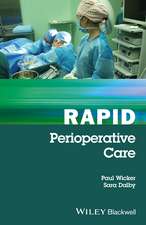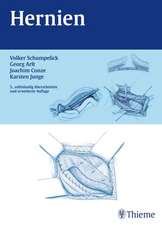Meshes: Benefits and Risks
Editat de Volker Schumpelick, Lloyd M. Nyhusen Limba Engleză Paperback – 22 aug 2014
Within a few years the surgical approach to abdominal wall hernias has focused on mesh-based treatment options. This dramatic change has set the stage for the third Suvretta meeting. All aspects of the mesh world have been discussed in detail by more than 50 international experts during an intense week resulting in an assessment of success and failures.
After posing the question, whether meshes have defeated recurrences in the groin, epidemiological clinical data on recurrences were presented and show that this problem still exists. In particular, novel molecular biology-based research results stress the pathophysiological importance of a defective scarring process in these patients with inherent conclusions for future therapies.
Regarding the variety existing meshes, there are already more than 100 different mesh devices, a comprehensive review of their chemical and textile properties was presented, with emphasis on their impact on biological responses. However, more than 90% of the participants articulated the need for improved mesh prosthesis, because their characteristic inflammatory and fibrotic foreign body reaction cause minor and major complications, e.g. pain, infections, adhesions, damage of the spermatic cord.
The differentiated use of meshes in various procedures was discussed, including groin, incisional, parastomal, diaphragmal and hiatal hernias as well as their use in extended abdominal wall defects or in paediatric or plastic surgery.
In summary this book summarizes the most up-to-date knowledge about meshes and hopefully serve as manual for both practical surgeons and scientists involved in the growing world of mesh.
Preț: 1244.33 lei
Preț vechi: 1309.82 lei
-5% Nou
Puncte Express: 1866
Preț estimativ în valută:
220.19€ • 258.20$ • 193.37£
220.19€ • 258.20$ • 193.37£
Carte tipărită la comandă
Livrare economică 13-27 februarie
Preluare comenzi: 021 569.72.76
Specificații
ISBN-13: 9783642622625
ISBN-10: 3642622623
Pagini: 500
Ilustrații: XVIII, 479 p. 219 illus., 38 illus. in color.
Dimensiuni: 155 x 235 x 26 mm
Greutate: 0.69 kg
Ediția:Softcover reprint of the original 1st ed. 2004
Editura: Springer Berlin, Heidelberg
Colecția Springer
Locul publicării:Berlin, Heidelberg, Germany
ISBN-10: 3642622623
Pagini: 500
Ilustrații: XVIII, 479 p. 219 illus., 38 illus. in color.
Dimensiuni: 155 x 235 x 26 mm
Greutate: 0.69 kg
Ediția:Softcover reprint of the original 1st ed. 2004
Editura: Springer Berlin, Heidelberg
Colecția Springer
Locul publicării:Berlin, Heidelberg, Germany
Public țintă
Professional/practitionerDescriere
The 3rd Suvretta meeting in January 2003 was intended to give an overview of the of meshes in hernia operations. After the first meeting in 1995 on Ingui current use nal Hernia and the second on Incisional Hernia in 1998, the current congress was focused on the benefits and risks of hernia meshes, the reason being that meshes have more and more become the standard in open as well as in laparoscopic hernia operations. During the past 10 years new indications for the use of mesh as well as new types of mesh have been developed. Considerable experience with meshes has been published in the literature, including controlled trials of different results, dif ferent techniques, and last but not least, case reports of complications. We there fore felt it was timely and appropriate to hold a state-of-the-art meeting on meshes used in hernia curative procedures. During 3 intense working days which included presentations, demonstrations, and extensive discussions, the current role and the future potential development of artificial mesh implants were discussed by both traditional and laparoscopic sur geons. The most renowned hernia specialists of the world came together to discuss the use of meshes relating to construction, material, technique, experimental stu dies and clinical results. Each participant was invited to give a special talk on his favorite subject for discussion among the attending specialists.
Cuprins
I. The Problem: How to Treat a Hernia Have we Defeated Hernia Recurrence in the Groin? An Epidemiological Approach (Lloyd M. Nyhus) 1.1 United Kingdom (A. Alani, and P. J. O’Dwyer) 1.2 Denmark (Henrik Kehlet, and Morten Bay-Nielsen) 1.3 Sweden (Agneta Montgomery) 1.4 Germany (M. Stumpf, U. Klinge, R. Rosch, K. Junge, and V. Schumpelick) 1.5 The Netherlands (M. P. Simons, and D. De Lange) 2. Risk Factors Predisposing for the Development of Incisional Hernias. A Retrospective Analysis of 2983 Cases Over a Period of 10 Years (J. Höer, G. Lawong, K. Junge, U. Klinge, and V. Schumpelick) 3. Expenses and Profits: Economical Aspects of Hernia Surgery (Andrew Kingsnorth) II. Reasons for Recurrency: A Pathophysiological Approach 4. Recurrences: The Fault of the Surgeon (R. Bendavid) 5. The Fault(s) of the Patient: Scar Reaction and Biological Recurrence (Raymond C. Read) 6. Collagen – the Crucial Cause? Molecular Regulation of Collagen Synthesis (Petra Lynen Jansen, Monika Knopps, Raphael Rosch, and Peter R. Mertens) 7. Pharmacotherapy of the Wound – Prevention of Hernia? (C. Wicke, S. Coerper, and H. D. Becker) III. The World of Mesh 8. Textile Variations and Characteristics of the Plastic nets Meshes (James R. DeBord) 9. Polypropylene – The Standard of Mesh Materials (Arthur I. Gilbert, Michael F. Graham, and Jerrold Young) 10. Polyester Mesh– a French Solution? (Jürgen Zieren, and Jochen M. Müller) 11. ePTFE: Worth the Prize? (Dieter BergerBerger D) 12. PVDF: A New Alternative? (Karsten Junge, Uwe Klinge, Raphael Rosch, Michael Stumpf, Bernd Klosterhalfen, and Volker Schumpelick) 13. The World of Mesh. Future Perspective: Tissue Engineering? (James Laredo, and Howard P. Greisler) IV. Anatomic Basis 14. The AbdominalWall – where to Place the Mesh? (A. Prescher, and J. Conze) V. Mesh Biology 15. Pathophysiology and Pathology of the Foreign Body Reaction to Mesh Implants (Felix A. Offner) 16. Long-Term Inertness of Meshes (Bernd Klosterhalfen, Uwe Klinge, Raphael Rosch, and Karsten Junge) 17. How to Construct a Mesh? Impact of Structure, Filament and Pore Size for Tissue Ingrowth (R. Rosch, K. Junge, F. Hölzl, A. Schachtrupp, M. Stumpf, and Uwe Klinge) 19.05 Preservation of the functional integrity of the abdominal wall: contradiction or requirement? (Stumpf Aachen) VI. Mesh-Related Complications: Exception or the Rule? – Impact of Technique and Material 18. Mesh Related Problems: How to Objectify (J. Conze, S. Truong, and V. Schumpelick) 19. Shrinkage: Fake or Fact? (Parviz K. Amid) 20. The Catastrophe: Mesh Infection and Migration with Fistula Formation – Life-Long Risk? Pathogenesis, Clinical Diagnosis, Managemenet, and Prevention (Maximo Deysine) 21. Prevention of Adhesions – Just an Illusion? (J. Conze, and V. Schumpelick) 22. Does the Mesh Damage the Spermatic Cord? (Christian Peiper, Karsten Junge, Uwe Klinge, Bernd Klosterhalfen, A. Öttinger, and Volker Schumpelick) 23. Complaints - Usual Complication of Meshes? (A. Alani, and P. J. O’Dwyer) 24. Foreign Body Carcinogenesis of Surgical Meshes (Bernd Klosterhalfen, Uwe Klinge, Karsten Junge, and Raphael Rosch) VII. Indication for Mesh Repair Today 25. Mesh Repair in the Groin: For Every Hernia at All Ages? (V. Schumpelick, U. Klinge, K. Junge, M. Stumpf, J. Conze, and R. Rosch) 26. Mesh Repair in the Abdominal Wall: Are There Mesh-Free Alternatives? (E. Schippers) 27. Mesh-Reinforced Repair of Diaphragmatic Hernia (Mark A. Carlson, and Constantine T. .Frantzides) 28. Parastomal Hernia: Prevention and Treatment? (Leif A.
Textul de pe ultima copertă
Within a few years the surgical approach to abdominal wall hernias has focused on mesh-based treatment options. This dramatic change has set the stage for the third Suvretta meeting. All aspects of the mesh world have been discussed in detail by more than 50 international experts during an intense week resulting in an assessment of success and failures.
After posing the question, whether meshes have defeated recurrences in the groin, epidemiological clinical data on recurrences were presented and show that this problem still exists. In particular, novel molecular biology-based research results stress the pathophysiological importance of a defective scarring process in these patients with inherent conclusions for future therapies.
Regarding the variety existing meshes, there are already more than 100 different mesh devices, a comprehensive review of their chemical and textile properties was presented, with emphasis on their impact on biological responses. However, more than 90% of the participants articulated the need for improved mesh prosthesis, because their characteristic inflammatory and fibrotic foreign body reaction cause minor and major complications, e.g. pain, infections, adhesions, damage of the spermatic cord.
The differentiated use of meshes in various procedures was discussed, including groin, incisional, parastomal, diaphragmal and hiatal hernias as well as their use in extended abdominal wall defects or in paediatric or plastic surgery.
In summary this book summarizes the most up-to-date knowledge about meshes and hopefully serve as manual for both practical surgeons and scientists involved in the growing world of mesh.















